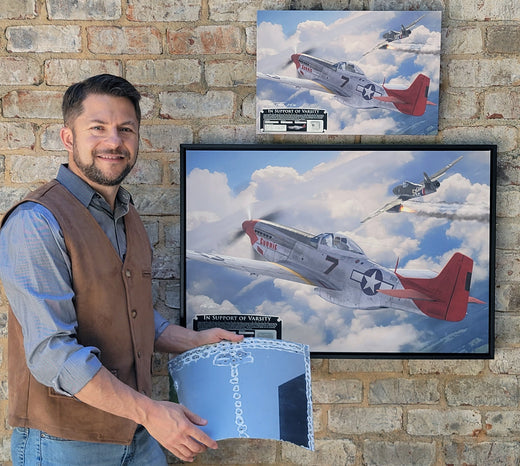This Fine Art Print by Artist Craig Tinder depicts the Tuskegee Airmen of the 332nd Fighter Group." This Limited Edition Canvas Print includes a fragment from a P-51D Mustang and Certificate of Authenticity.
Details About the RELIC:
 P-51D Mustang 44-73990 Skin relics from a 15-year restoration
P-51D Mustang 44-73990 Skin relics from a 15-year restoration
This particular fragment of a P-51D-25-NA Mustang came from the fuselage panel of aircraft 44-73990 (Construction No. 122-40530). Built in 1944, it initially served with the US Army Air Force before being transferred to the Royal Canadian Air Force in 1951.
After changing hands several times, the aircraft eventually joined the air racing circuit under the name "Pigeon Chaser." It was flown by the legendary R.A. "Bob" Hoover as the pace plane for the 1971 Cape May National Air Races.
 P-51D Mustang 44-73990 Air Racer "Pigeon Chaser"
P-51D Mustang 44-73990 Air Racer "Pigeon Chaser"
From 2000 to 2015, the aircraft underwent extensive restoration and is now painted in the livery of the 353rd Fighter Group.
 Artist, Craig Tinder, holding a P-51 fuselage panel that is used as the relics included in the "In Support of Varsity" limited edition prints
Artist, Craig Tinder, holding a P-51 fuselage panel that is used as the relics included in the "In Support of Varsity" limited edition prints
The Story Behind the Print:
24 March 1945 - During the massive Allied airborne operation known as Operation Varsity, 1Lt Roscoe Brown of the famed Tuskegee Airmen achieved a milestone victory, marking his first aerial kill of the war. Flying his P-51 Mustang as part of the 332nd Fighter Group, known for their distinctive "Red Tails," Brown encountered a formidable adversary: the Messerschmitt Me 262, the world's first operational jet fighter. This engagement was one of the first where the Tuskegee Airmen went head-to-head with the revolutionary Me 262s, piloted by experienced Luftwaffe aces, including Oberleutnant Franz Kulp of Jagdgeschwader 7 (JG 7), the first operational jet fighter unit in history.
As the escort group provided cover for 15th Air Force bombers, 53 P-51 Mustangs from the 332nd Fighter Group found themselves in the crosshairs of 25 Me 262 jets. The Me 262, with its unparalleled speed and firepower, posed a significant threat to the Allied bombers. Despite the technological advantage of the German jets, Brown and his fellow pilots displayed exceptional skill and courage in facing the enemy head-on. In the ensuing aerial dogfight, Brown successfully shot down one of the Me 262s, piloted by Franz Kulp, marking a rare achievement for a propeller-driven aircraft against a jet fighter.
The encounter was a testament to the Tuskegee Airmen's skill and determination. As part of their escort duties during World War II, the "Red Tails" were responsible for protecting bombers from enemy fighters, often ensuring the safe return of Allied crews. The 332nd Fighter Group distinguished itself with an impressive record: across 312 escort missions, they lost only 27 bombers, far below the average of 46 lost by other fighter units. This success earned the Tuskegee Airmen a reputation as some of the most reliable and effective fighter pilots in the war.
 Artist Craig Tinder and Red Tail Pilot, Dr. Eugene Richardson during the monument dedication at Walterboro Army Air Base, Walterboro, South Carolina - 2023. Monument designed by Artist Craig Tinder. Adorning the top of the monument is a bronze bust of 1LT Roscoe Brown
Artist Craig Tinder and Red Tail Pilot, Dr. Eugene Richardson during the monument dedication at Walterboro Army Air Base, Walterboro, South Carolina - 2023. Monument designed by Artist Craig Tinder. Adorning the top of the monument is a bronze bust of 1LT Roscoe Brown
Learn more about Who were the Tuskegee Airmen and what is their importance in American History? Click Here
To purchase or see similar items, visit here.
Commissioned by Museums, Treasured by Collectors





Share:
The Final 3, the story behind "The Push Back"
Sherman in Battle, the story behind "Operation Bluecoat"